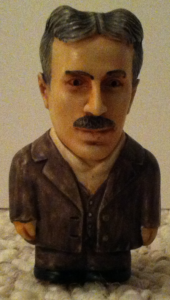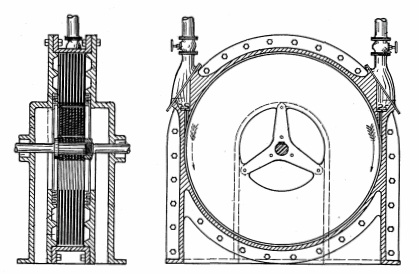 When he was not taking on Einstein, Nikola Tesla was thinking about some of the fundamental “truths” of science. In one case he disagreed with the idea that turbines needed to have blades like a propeller to catch the air or water as they moved in a particular direction. Tesla had experimented with what would come to be called the bladeless turbine as far back as his youth when he played with waterwheels of his own invention. His updated version of a bladeless turbine could be used, Tesla mused, to power “automobiles, locomotives and steamships,” not to mention airplanes and ocean liners, all new creations of the modern world of the early twentieth century.
When he was not taking on Einstein, Nikola Tesla was thinking about some of the fundamental “truths” of science. In one case he disagreed with the idea that turbines needed to have blades like a propeller to catch the air or water as they moved in a particular direction. Tesla had experimented with what would come to be called the bladeless turbine as far back as his youth when he played with waterwheels of his own invention. His updated version of a bladeless turbine could be used, Tesla mused, to power “automobiles, locomotives and steamships,” not to mention airplanes and ocean liners, all new creations of the modern world of the early twentieth century.
 Tesla had begun working on bladeless turbines when he was consulting with the Westinghouse Company in Pittsburgh, but this project, like so many others, was put on hold while he toiled on his alternating current designs of high potential and high frequency. But in 1906 he gave himself a fiftieth birthday present by demonstrating his bladeless turbine in public. The basic design of the turbine relies on the principle of boundary layer flow, that is, where the movement of the liquid or gas passes over a series of smooth disks. Some of the liquid or gas adheres to the disks, which creates a vortex that spirals toward the center and spins the turbine. Tesla described it in an interview with the New York Herald in 1911:
Tesla had begun working on bladeless turbines when he was consulting with the Westinghouse Company in Pittsburgh, but this project, like so many others, was put on hold while he toiled on his alternating current designs of high potential and high frequency. But in 1906 he gave himself a fiftieth birthday present by demonstrating his bladeless turbine in public. The basic design of the turbine relies on the principle of boundary layer flow, that is, where the movement of the liquid or gas passes over a series of smooth disks. Some of the liquid or gas adheres to the disks, which creates a vortex that spirals toward the center and spins the turbine. Tesla described it in an interview with the New York Herald in 1911:
“Now, suppose we make this metal plate that I have spoken of circular in shape and mount it at its centre on a shaft so that it can be revolved. Apply power to rotate the shaft and what happens? Why, whatever fluid the disk happens to be revolving in is agitated and dragged along in the direction of rotation, because the fluid tends to adhere to the disk and the viscosity causes the motion given to the adhering particles of the fluid to be transmitted to the whole mass.”
This resulted in very large power output for a very small size and weight. Because no projecting blades were needed, the turbine could withstand much greater pressures.
But that wasn’t the only unusual device he mentioned. More on that in the book.
[Adapted from Tesla: The Wizard of Electricity, now into its 8th printing and translated into multiple languages.]
David J. Kent is the author Tesla: The Wizard of Electricity and Edison: The Inventor of the Modern World, plus two e-books: Nikola Tesla: Renewable Energy Ahead of Its Time and Abraham Lincoln and Nikola Tesla: Connected by Fate. His latest book is Lincoln: The Man Who Saved America, in Barnes and Noble stores now.
Check out my Goodreads author page. While you’re at it, “Like” my Facebook author page for more updates!











Aha! “Boundary behavior”.
Yup!